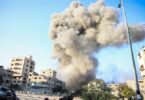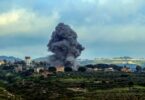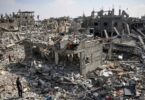Fadi Farasin
Can the Organization of Islamic Cooperation remain relevant for 21st Century?
The number of conflicts in the countries of the Organization of Islamic Cooperation (OIC) is on the rise and so is their intensity. Currently, more than 60 percent of all conflicts in the world occur in OIC countries. These conflicts lurk in the shadows of fear and frustration, breeding on despair and disillusionment, fed by poverty and extremism. Conflicts of our times are manifestations of growing anger, hatred and a sense of helplessness, injustice, oppression and the denial of fundamental freedoms and rights.
The consequences of the raging violence in OIC countries have been devastating. It is a human tragedy that has taken its toll on people’s lives. More than 80 percent of global conflict fatalities and almost 90 percent of global terrorism fatalities have taken place in OIC countries. Millions of people have been forced to leave their homes. Two-thirds of world refugees originate from OIC countries. In addition, certain Muslim minorities and communities living in non-OIC countries are in conflicts or facing security challenges. Preventing conflict is the least costly way to avoid its consequences.
In order to do so, there is a need to understand the drivers of conflict and eliminate them. The causes and effects of conflicts are not independent from each other. They are intertwined, and in many cases, the lines between them are obscure. One of the main causes and consequences of conflict is inequality, which plagues many OIC countries. When social differences coincide with economic and political differences between groups, the result is deep resentment that may lead to violent struggles. Human development is another central theme in the discussion of what drives conflict and its impact on society. A larger share of OIC countries remains low on the human development index compared to other regions. The majority of OIC countries with low human development levels have suffered or have been suffering from major conflicts.
Political and social exclusion can also be powerful contributors to upheaval leading to conflict. In OIC countries, the level of political participation and political and social integration is rather weak. This fact has rendered OIC countries vulnerable to unrest as has been seen in a number of OIC countries since the beginning of the so-called Arab Spring in 2011. Furthermore, conflicts, since the mid-1990s, have occurred in weak states that have experienced conflict repeatedly. Weak institutions are a factor in the outbreak of conflicts; they have also been the outcome of violent conflicts. Unfortunately, many OIC countries suffer from weak states and poor governance.
One of the major missions of the OIC is to promote international peace and harmony among various people of the world. Achieving this requires the OIC to be actively involved in conflict resolution and mediation. When examining the history of OIC mediation and conflict resolution, one can observe what worked and what went wrong. The OIC experience in the Southern Philippines underlined the importance of implementing resolutions and the pitfalls of leaving prematurely.
The OIC experience in Thailand and China shined a light on ethnic divisions as a factor and how it should always be on the mind of the mediator as it could play either a negative or positive role. When genocide, war crimes, ethnic cleansing and crimes against humanity have occurred, it is vital for the OIC to strike a balance between the principles of sovereignty and inadmissibility of intervention in the domestic affairs of states and the principle of responsibility to protect. We have learned the importance of NGOs and that sometimes a combination of official and non-official efforts is the best formula. We have learned from the “War on Terror” that the OIC must encourage dialogue and engagement even when parties to a conflict are throwing around the label of terrorism.
Resolving disputes in a timely manner before the number of parties grows is of paramount importance. The OIC has leverage, however, which it must use, influence, and incentivise wisely without false promises. And finally, the OIC needs to increase its capacity in regard to models and proposals for innovative approaches especially in the fields of power and wealth sharing. The OIC peace and security architecture flows from the OIC Charter, which aims to promote inter-state relations based on justice, mutual respect and neighbourliness to ensure global peace, security and harmony.
For the peace and security architecture of the OIC to fulfil its promise, it has to be fully functional and the components have to work with each other in an integrated and synchronized manner. Unfortunately, this is not the case. The OIC peace and security architecture lacks an overall and primary organ for overseeing peace and security issues. For example, the United Nations has the UN Security Council and The African Union has the Peace and Security Council.
Another missing component in the OIC peace and security architecture is a peace force. A peace force is needed to provide security and political and peace-building support to help countries make the difficult, early transition from conflict to peace. The last component that is missing from the OIC peace and security architecture is an early warning system. An early warning system is a necessity for the OIC so that conflicts can be reported in a timely fashion. A timely warning will lead to timely actions.
Against this backdrop, The Statistical, Economic and Social Research and Training Centre for Islamic Countries (SESRIC) report titled “Achieving Peace and Security in a World of Turmoil: An Arduous Challenge for the OIC” delves into the trends of violence and conflict in OIC countries, and their driving factors and implications. The report goes beyond explanations to probing the required ingredients for conflict prevention and management in OIC countries; enhancing the OIC peace and security architecture; developing institutional mechanisms for sustainable peace and security in OIC countries; and exploring alternative paths for achieving enduring peace. Finally, governments of OIC member states have to realize that they have responsibilities towards each other and that they have many challenges in common. By deepening security cooperation, the OIC has a good chance at consolidating stability as well as boosting economic development of its member states.
*The Organization of Islamic Cooperation (OIC) is the collective voice of the Muslim world. It is the second largest inter-governmental organisation after the United Nations with a membership of 57 states.






